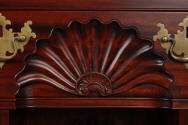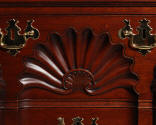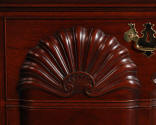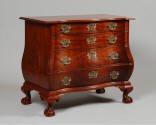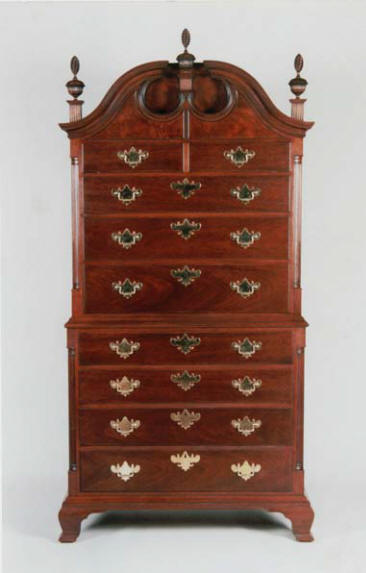
mahogany, 89"h, 44"w, 24"d
To stand before a John Townsend chest-on-chest is to be in the presence of greatness. This is a monumental design by John Townsend with fluted quarter columns on both upper and lower cases. It stands on ogee bracket feet and is crowned with a closed pediment. The pediment has bookmatched panels and three fluted finials on fluted plinths. Bold brasses complete the facade and contrast handsomely with the rich mahogany.
Joinery throughout is by hand-cut dovetails in the precise manner of John Townsend. The mahogany for the drawer fronts is chosen carefully for the best graining and appearance.
The original is in the collection of the Newport Historical Society and may be seen at the Museum of Newport History in the Brick Market building on Washington Square.
similar example: Greene p. 69
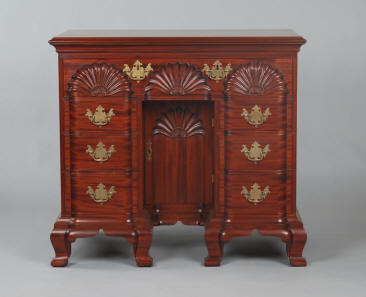
mahogany, 34"h, 36"w, 20½"d
The Newport four-shell kneehole bureau as made by John Townsend is near square in proportions and highly detailed in its carving. The top drawer features three shells with palmette centers in Townsend's crisply detailed style, and the kneehole door has one more. The blocked form extends down the drawer fronts, base molding, and feet to end in crisp carved volutes.
The case and drawers are joined with hand-cut dovetails in John Townsend's precise and detailed style. The blocked drawers are cut from solid mahogany taken from one plank for uniform color and graining.
similar example: Moses plate 23
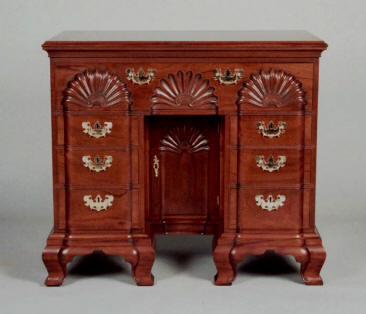
mahogany, 33"h, 36½"w, 20½"d
A four-shell kneehole bureau after an original by Edmund Townsend, Newport's most prolific maker of kneeholes. The kneehole bureaus are similar to block-front chests, but added the center kneehole and additional feet for more visual interest. The shells are in Edmund Townsend's signature style with palmette centers, and the blocking extends down the facade, base molding, and feet to terminate in carved volutes. The block-and-shell kneehole door opens to reveal two shelves.
The drawers and case are fully dovetailed throughout. The drawer fronts are carved from the solid and taken from one plank of mahogany for consistency.
similar example: Moses p. 285
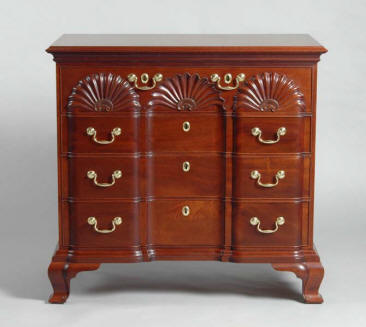
mahogany, 34 1/2"h, 37"w, 20"d
The crisp precision of John Townsend is evident in this four-drawer block-front chest design. The top drawer features three highly detailed Townsend shells with later basket palmette centers. The blocking continues down over four drawers and the ogee base molding to terminate in tight volutes on the ogee feet. In keeping with John Townsend's style, the proportions are near square and the features are detailed.
All the blocked drawers, molding, and feet are cut from the solid, and the joinery is by dovetails in Townsend's precise manner throughout. Drawer fronts are taken from a single plank for consistency. This example has later Federal-era brasses, but earlier (and larger) Chippendale-style brasses are equally appropriate.
similar examples: Sack p. 111 or Moses p. 76.
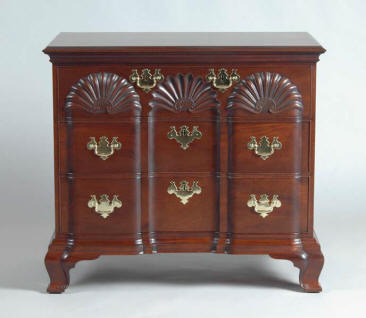
mahogany, 32 1/2"h, 36"w, 20"d
A three-drawer block-front chest in the relaxed style of Edmund Townsend. Edmund Townsend likely created more block-front case pieces than any of his contemporaries in 18th-century Newport. His prolific work and proficiency in this style resulted in compositions that are balanced and comfortable. The graceful design belies the difficulty of the work involved.
Here the blocked front is topped with three fully hand-carved shells with traditional palmette centers on the top drawer. The fully blocked drawers are cut entirely from solid stock and from the same plank for a uniform appearance. The blocking extends through the ogee base molding and ends in volutes on the feet. the case and drawers are all fully hand-dovetailed in the manner of Edmund Townsend.
similar example: Moses plate 19
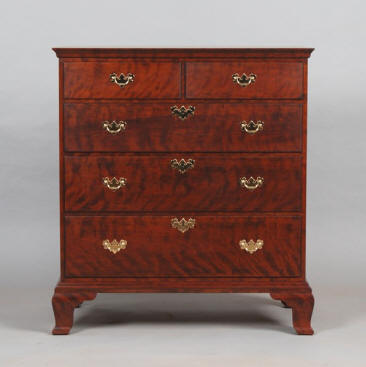
mahogany, 41½"h, 37½"w, 20"d
An example of a Newport chest of drawers in a simple, flat-front design with ogee feet. From an original by Christopher and/or a young John Townsend, and proof again that the elegance of Newport designs lies in proportion and line rather than ornament.
This chest has dovetail joinery throughout with through dovetails visible on the top of the case. The original was made in figured maple, but it is equally attractive in mahogany and other woods (figured maple and cherry below)
The original, having lost its feet, was once thought to have been the top of a highboy. Enough of the outlines of the original feet were visible to determine it was in fact a chest, and the only one of its kind. The feet were restored and it is in service as a chest of drawers today.
similar example: Greene p. 229
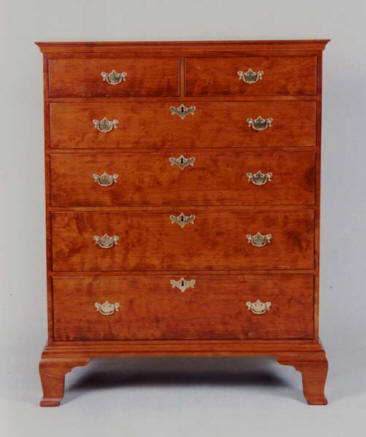
cherry, 48"h, 37½"w, 20"d
A slightly taller version of the Townsend five-drawer chest with the addition of one extra drawer. It's a handsome design with plenty of capacity.
It is dovetailed in the manner of the original five-drawer version, with exposed half-blind dovetails visible on the top.
The Townsend six-drawer chest is shown here in figured cherry but is equally attractive in figured maple, mahogany, and walnut.
figured maple 65"h, 39"w, 21"d available
Somewhere between a chest of drawers and a high chest, a chest-on-frame is a relatively rare form. This Newport version has a case of five graduated, full-width drawers atop a Newport slipper-foot frame. The scrolled base apron has a central pendant drop.
The base frame is of pegged mortise-and-tenon construction and the upper case and drawers are dovetailed. It is shown here in figured cherry, but it is equally attractive in maple (inset), mahogany, or walnut.
similar example: Venable p. 16
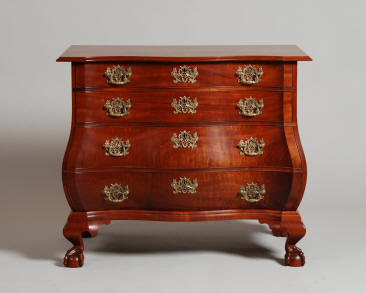
mahogany, 32"h, 38"w, 20"d
There are few American furniture forms as intriguing as the bombé. The name comes from from the French for "bulged", and the style was most popular in the Boston, being used in chests, chest-on-chest bases, desks, and desk bookcases. As made by American makers, the sides and fronts are carved from solid 3" thick mahogany.
This example adds the further appeal of a reverse-serpentine front. The profile of the sides and the compound curves of the front reveal spectacular patterns in the grain of the mahogany. The plates of the Chippendale-style pulls are bent so as to follow the curves of the surface. In addition, the chest stands on four strong ball and claw feet made in the Boston style with back-swept side digits.
similar example: Greene p. 258
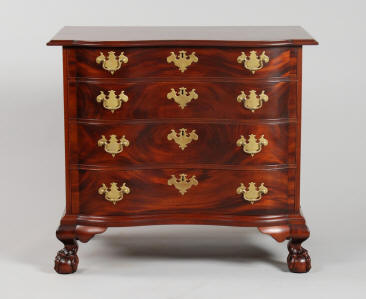
mahogany, 32½"h, 37"w, 21½"d
The Boston serpentine-front chest is a stately and impressive chest of drawers, embodying all the ideals of the Chippendale era. The serpentine treatment of the front reveals the stunning grain pattern of mahogany. This design also features blocked ends, bold brasses, and powerful Boston-style ball and claw feet.
The drawer fronts are cut from solid mahogany in excess of 2 inches in thickness. They are taken from one plank to assure uniform appearance and graining throughout.
similar example: Sack p. 103

